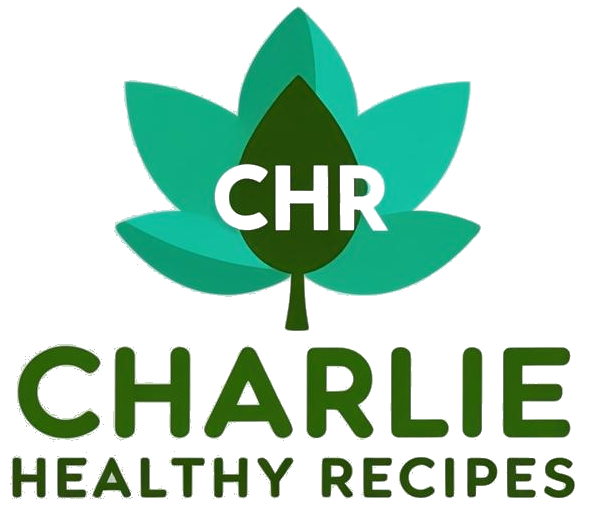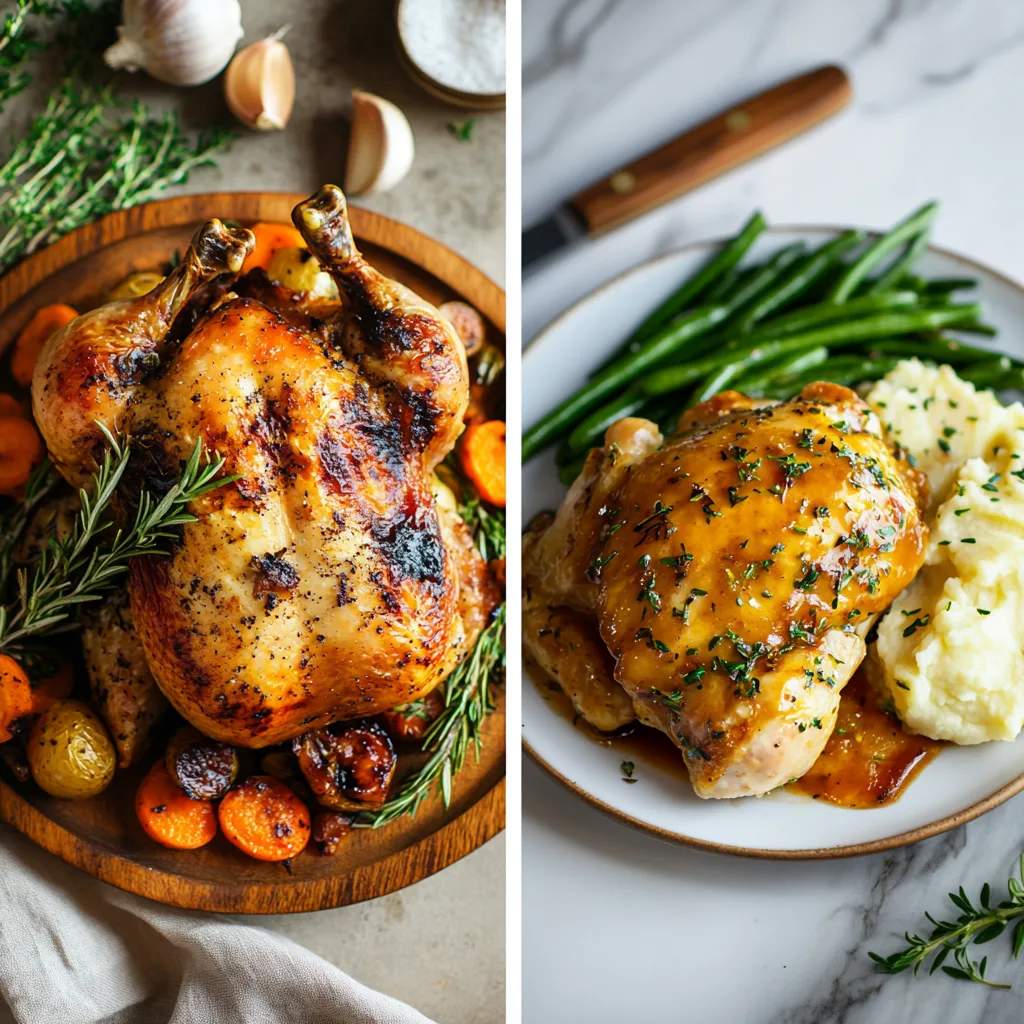🐔 Difference Between Baked and Roast Chicken: A Complete Guide
🍽️ Part 1: Introduction & Core Definitions
🍗 What Makes Baked and Roast Chicken So Popular?
Chicken is a kitchen staple and one of the most adaptable proteins available. Whether you’re feeding a family or meal-prepping for the week, it’s likely you’ve wondered: What’s the real difference between baked and roast chicken?
Though both methods use an oven, they differ significantly in technique, texture, and flavor. Choosing the right one can completely elevate your dish. This comprehensive guide will explain everything you need to know about these two cooking methods, from how they work to when to use each.
To ensure food safety, always follow the USDA’s official chicken temperature guidelines, which recommend cooking chicken to an internal temperature of 165°F (75°C).
And if you’re aiming for that golden, crispy finish, check out this expert roasting guide by Serious Eats to learn how roasting impacts flavor and texture.
🔍 What is Baked Chicken?
Baked chicken is prepared using indirect, enclosed heat — typically in an oven — at a moderate and consistent temperature, usually between 325°F and 375°F.
- It’s often cooked in a covered dish or wrapped in foil.
- This traps steam and moisture, resulting in tender and juicy meat.
- Baking is ideal for boneless, skinless chicken breasts or thighs.
- It’s the go-to method when you want to avoid drying out the chicken.
This method also helps retain nutrients, making it a great choice for health-conscious eaters. For delicious ideas, browse nutritious baked chicken ideas from Charlie Recipes.
🔥 What is Roast Chicken?
Roasting, on the other hand, uses high dry heat — usually set at 400°F and above. This technique is designed to create a crispy exterior while sealing in flavor.
- It’s done uncovered, often using a roasting pan or rack.
- Perfect for whole chickens or bone-in cuts.
- Yields that signature crispy golden skin.
- Flavor is enhanced through browning and caramelization.
If you’re a fan of bold, savory crusts and rich taste, consider this classic roast chicken method for your next meal.
But be warned — roasting requires more attention to prevent overcooking. Learn what to avoid in this helpful guide on common roasting mistakes.
🥘 Part 2: Technical & Culinary Differences Between Baked and Roast Chicken
🌡️ Cooking Environment Comparison
One of the main differences between baking and roasting lies in the type of heat used and the cooking environment:
- Baking uses indirect, ambient heat in a more closed environment—ideal for even, gentle cooking.
- Roasting employs direct, high dry heat that surrounds the chicken, usually at 400°F or higher.
These differences impact not only the flavor but also the texture, moisture levels, and cooking times.
🥩 Texture and Flavor Profiles
Each method gives chicken a distinct mouthfeel and flavor. Here’s how they compare:
- Baked chicken tends to be softer, more tender, and juicier, especially when covered.
- Roast chicken has a crisp skin and rich, caramelized flavors thanks to the Maillard reaction at high temperatures.
To maximize flavor, marinate or brine the chicken before cooking, no matter which method you choose.
🍳 Equipment Used
The tools you use can directly affect the outcome. Here’s a quick comparison:
- Baking tools: Baking dish, aluminum foil, Dutch oven, parchment paper.
- Roasting tools: Roasting pan with rack, cast iron skillet, meat thermometer.
Using a roasting rack helps elevate the bird for even browning. A Dutch oven traps steam during baking, creating moisture-rich results.
🍗 Ideal Chicken Cuts for Each Method
Choosing the right cut is essential for success:
- Baking: Great for boneless breasts, thighs, and drumsticks—especially when cooked in sauce or marinade.
- Roasting: Best for whole chickens or bone-in, skin-on cuts that benefit from dry heat and crisping.
⏱️ Cooking Time and Temperature
Time and temperature are crucial to both safety and flavor. Here’s a general breakdown:
- Baked chicken: 350°F for 25–35 minutes depending on cut size and thickness.
- Roast chicken: 400–450°F for 45 minutes to 1.5 hours for a whole bird.
Always use a thermometer to ensure chicken reaches 165°F (75°C) internally. If you’re unsure about timing, this guide on how to bake chicken breasts from The Kitchn is a valuable resource.
🥦 Nutritional Comparison
While both methods are relatively healthy, there are subtle differences:
- Baking generally retains more moisture and nutrients due to the lower, covered cooking temperature.
- Roasting may cause slightly more fat to render out, but it also creates a more concentrated flavor.
For a balanced approach, pair your chicken with veggies like carrots, onions, and broccoli—many of which can roast alongside your protein for added depth.
🍴 Part 3: Culinary Applications & Pros/Cons
📖 Popular Recipes Using Each Method
Depending on your desired outcome, certain recipes are better suited to baking or roasting. Let’s look at some common favorites:
✅ Baked Chicken Recipes
- Honey garlic baked chicken thighs
- Lemon herb baked chicken breasts
- Cheesy baked chicken and broccoli casserole
🔥 Roast Chicken Recipes
- Whole roast chicken with lemon and rosemary
- Spatchcocked roast chicken with garlic rub
- Roasted chicken and vegetables in one pan
One fan favorite for flavor and simplicity is this herb-crusted roast chicken recipe — a perfect introduction to roasting with dry heat.
🧂 Flavor Infusion Methods
Whether baking or roasting, how you season your chicken makes all the difference:
- Marinades work well for both, especially for baked dishes where moisture is retained.
- Dry rubs are ideal for roasted chicken to create a crust and enhance browning.
- Brining adds moisture and tenderness, particularly helpful when baking lean cuts like breasts.
For a deeper dive into flavorful, healthy prep, explore nutritious baked chicken ideas that incorporate brining, herbs, and marinades.
⚖️ When to Choose Baking Over Roasting (and Vice Versa)
Need help deciding whether to bake or roast your chicken? Consider these factors:
- Choose baking if:
- You want a low-maintenance, juicy chicken dish.
- You’re cooking boneless or smaller cuts.
- You want to cook in sauces or liquids.
- Choose roasting if:
- You want a crispy, golden skin.
- You’re cooking a whole bird or bone-in cuts.
- You want a bold, caramelized flavor.
👍 Pros and Cons of Baked Chicken
- Pros:
- Low risk of burning or drying out
- Great for marinades and sauces
- Cons:
- Skin doesn’t crisp well
- Less flavor development compared to roasting
🔥 Pros and Cons of Roast Chicken
- Pros:
- Bold, intense flavor
- Crispy, golden-brown skin
- Excellent presentation for whole chickens
- Cons:
- Requires more attention to prevent drying out
- Higher heat may overcook smaller cuts
👨🍳 Part 4: Cooking Tips, Techniques, and Common Mistakes
🥘 How to Perfectly Bake Chicken
Baking chicken may seem straightforward, but these tips will help you get consistently juicy and flavorful results:
- Preheat the oven to ensure even cooking from the start.
- Use a meat thermometer to avoid undercooking or drying out the chicken.
- Cover the chicken with foil or a lid to trap moisture.
- Let it rest for 5–10 minutes before slicing to retain juices.
🔥 How to Perfectly Roast Chicken
Roasting chicken requires slightly more technique but rewards you with amazing texture and flavor. Here’s how to master it:
- Use a roasting rack to lift the chicken and promote even browning.
- Brush the skin with oil or butter to help it crisp up.
- Start at a high heat (450°F for 15 minutes), then reduce to 375°F to finish cooking evenly.
- Rest the chicken after roasting so juices redistribute.
🚫 Common Mistakes When Baking Chicken
- Skipping the thermometer: Leads to over- or undercooking.
- Not pre-seasoning: Baking doesn’t produce the same flavor depth as roasting, so seasoning is vital.
- Cooking uncovered for too long: Results in dry chicken.
⚠️ Common Mistakes When Roasting Chicken
- Overcrowding the pan: Prevents proper browning and leads to steaming.
- Forgetting to baste or oil the skin: Results in pale, dry exterior.
- Not letting the bird rest: Causes flavorful juices to leak out during carving.
Still making errors? Check out this guide on common roasting mistakes to level up your technique.
🌡️ Temperature Charts and Internal Thermometer Tips
Always rely on a thermometer for doneness — looks can be deceiving. Here’s a quick cheat sheet:
- Whole roast chicken: 165°F in the thickest part of the thigh (not touching bone)
- Chicken breasts: 160°F, then rest to rise to 165°F
- Drumsticks or thighs: 170°F–175°F for best texture
Insert the thermometer from the side into the thickest part of the meat, avoiding bone, for the most accurate reading.
❓ Part 5: FAQs, Internal Links, and Final Thoughts
🙋 Frequently Asked Questions (FAQs)
1. Can you roast chicken in a baking dish?
Yes, but with a caveat. Roasting requires dry heat, so avoid covering the chicken and ensure there’s space for air to circulate. A baking dish works if it’s not too deep and the chicken is elevated with a rack.
2. Is baked chicken healthier than roasted chicken?
Both are healthy, but baking typically retains more moisture and nutrients due to the lower cooking temperature. Roasting renders more fat and can be slightly crispier, but both methods are excellent for lean protein meals.
3. What’s the difference in taste between baked and roast chicken?
Baked chicken is often juicier with milder flavor, especially if cooked in sauces or marinades. Roast chicken has a more intense, savory flavor with crispy skin and caramelized exterior.
4. Can you roast chicken without a roasting pan?
Absolutely! You can use a cast iron skillet, baking sheet, or even a grill-safe pan. Just make sure to elevate the chicken if possible for better airflow and crispiness.
5. Should you cover chicken when baking?
Yes — especially for boneless cuts — as it helps retain moisture and prevent drying. For a crispy top, uncover the chicken during the last 10 minutes of baking.
6. Which is better for meal prep: baked or roast chicken?
Baked chicken is often the better choice for meal prep. It’s easier to batch-cook and store, and it stays moist when reheated. However, roasted chicken is fantastic for weekend family dinners or entertaining guests.
🔁 Internal Linking Opportunities
To increase SEO and provide additional context to readers, use the following internal links with rich anchor text:
- classic roast chicken method — Ideal when discussing roast recipes
- nutritious baked chicken ideas — Use when discussing health benefits of baking
- common roasting mistakes — Embed when discussing techniques and tips
🔗 External Link Summary (With Anchor Text)
These trusted resources offer helpful, non-competitive content that enrich your article:
- safe chicken cooking temps — For USDA cooking guidelines
- expert roasting guide — To support flavor and crisping advice
- how to bake chicken breasts — To assist readers with timing and method
✅ Final Thoughts
Whether you choose to bake or roast your chicken ultimately depends on your preferences, time, and the cut you’re working with. Baking offers a juicy, soft result ideal for weekly meal prep or saucy dishes. Roasting delivers unbeatable flavor and crispy skin—perfect for impressing guests.
By understanding these two methods, you’ll elevate your chicken dishes and master one of the most important techniques in home cooking. And remember, regardless of the method, proper seasoning, cooking temperature, and rest time are key to chicken perfection.
Ready to put your skills to the test? Try this herb-crusted roast chicken recipe or browse more baked chicken recipe ideas and explore the delicious difference yourself.

